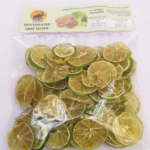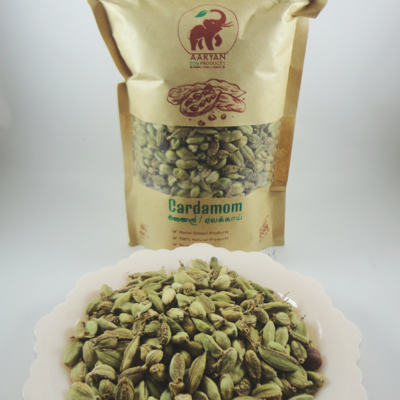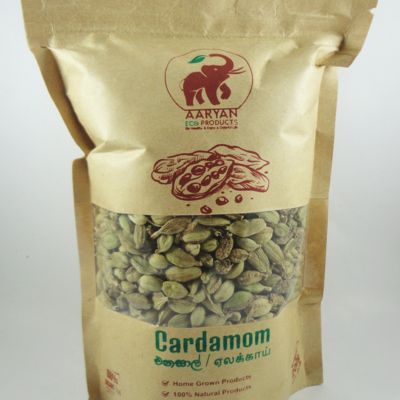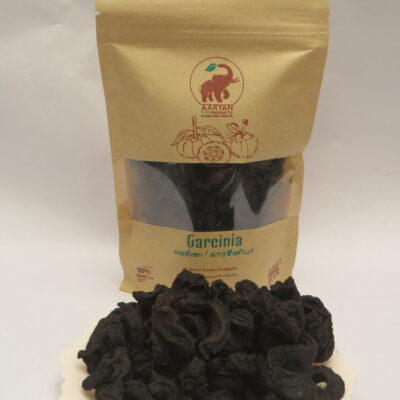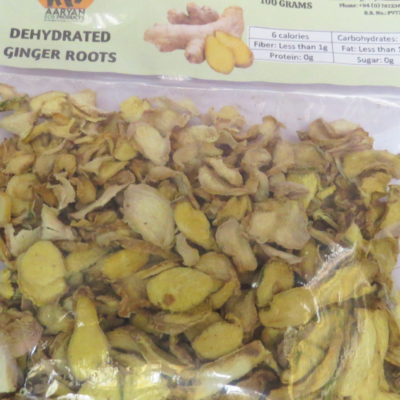Ceylon Mace, sun-dried : 100% Natural and Pure Blades -100g pack
$12.00
Mace is a yellowish-brown spice that is derived from the dried lacy coating of the nutmeg seed. Available in ground form and as dried “blades,” it is often paired with other aromatic spices. Mace figures prominently in Asian, Caribbean, Indian, and Moroccan cuisines, and is also used in British, Dutch, and French cooking. It is commonly found in spice blends and baked goods, as well as savory dishes like soups, sauces, and poultry and fish recipes. The “mace” that is used as a defensive pepper spray has no relationship to the spice.
The nutmeg tree (Myristica fragrans) is a tropical evergreen that produces both nutmeg and mace. Mace is the red lacy coating (called the aril) that encases the nutmeg seed. When the tree’s fruit reaches maturity, it splits open and reveals the aril and seed. The fruit is harvested and the aril is removed by hand, flattened, and left to dry outside for 10 to 14 days. The red aril takes on an amber-, yellow- or orange-brown color as it dries and, when left whole, is called a “blade” of mace. The blades are sold as is or processed into a ground spice.
4 in stock
SHIPPING
- Complimentary ground shipping within 1 to 7 business days
- In-store collection available within 1 to 7 business days
- Next-day and Express delivery options also available
- Purchases are delivered in an orange box tied with a Bolduc ribbon, with the exception of certain items
- See the delivery FAQs for details on shipping methods, costs and delivery times
RETURNS AND EXCHANGES
- Easy and complimentary, within 14 days
- See conditions and procedure in our return FAQs
Have a question?
Description
Ceylon Mace, 100% Natural and Pure , 100g pack from inland mid-elevation wet zone cultivations
| Condition | Fresh mace, dried under the recommended temperature and weather conditions, unused, unopened |
| Quantity | One pack |
| Status | Natural flavor & aroma, dried clean mace blades , reddish-brown color |
| Food specification | Caffeine Free, Dairy Free, Diabetic, Dye Free, Egg Free, Fat-Free, Gelatin Free, Gluten-Free |
| Country/ Region of cultivation | Sri Lanka- from Matale & Kandy regions and inland wet zone cultivations |
| Product | Sealed pack of dried mace (nutmeg) –reddish-brown color |
| Food Aisle | Pantry |
| Expiration Date | 18 months from the production date |
| Packed country & location | Sri Lanka-Piliyandala |
| Shipping | FREE Shipping |
| Ships from | Sri Lanka |
| Ships to | Worldwide (Except for the countries that have restrictions). The buyer should check all the policies, taxes, customs duties, etc. applicable to their country before placing an order and making payment |
| Delivery | Estimated within 12 -30 working days |
| Shipment | We ship the item within 3–4 working days after receiving cleared payment. |
| Payments methods | Card Payments |
Delivery
Registered Post Tracking
Payments
We only accept payment via the website, Aaryan Eco Products’ payment gateway.
Shipping
The items will be shipped to your registered address. Please make sure your “shipped to” address is correct.
All orders will be shipped within 3 to 4 business days.
All the items will be packed carefully and in good condition.
The arrival time depends on your location. The time may get longer due to special holidays and various clearances of the customs department.
If you did not receive your package within the time frame, please do not hesitate to contact us.
Return Policy
We accept returns within 07 business days from item arrival, provided it is unopened and unused.
Thank you for purchasing!
It would be very much appreciated and great to receive your feedback about our products and services.
Aaryan Eco Products’ theme is to introduce Sri Lankan eco-friendly products, crafts, spices, pure black tea, healthy pure natural herbal and cereal products with trust.
Description, Nutrition Contents & Health Benefits
As mentioned before, Sri Lanka is not only a paradisiacal island on the earth but also a gift of God. The soil and geological formation are miraculous. The island’s earth is blessed by nature. The tropical climate is ideal for spice cultivation. Sometimes the mother country is different and far away from Sri Lanka for most of the spices, but once those are planted in Sri Lankan earth the flavors, tastes, and aromas become unique. That is one of the main reasons that many buyers and consumers are tempted to buy spices from Sri Lanka.
Although mace is sold in whole pieces called blades, it’s more common to find the ground form. As with nutmeg, for the truest flavor, it is best to purchase whole mace blades and grind them as needed. However, ground mace does keep its flavor longer and better than ground nutmeg and other spices. When switching between the two forms, be mindful that one tablespoon of mace blades is equivalent to one teaspoon of ground mace
Mace’s flavor is sweet, woody, and warm, with a mild pungent kick, very much like nutmeg but softer and not quite as sweet. The taste of mace can also be described as a combination of cinnamon and pepper.
Originating from the same tree, Nutmeg and mace are siblings in the spice world. Nutmeg is the oval-shaped fruit, while mace is the reddish webbing that wraps around the pit. Nutmeg and mace are perhaps most famous for their applications in desserts such as cakes and pies, but they also find themselves in quite a few savory applications, such as sausages or stews, and are notably an essential ingredient for some seasonal Christmas beverages like eggnog.
Nutmeg and mace are two separate spices derived from the fruit of the tree Myristica fragrans of the family Myristicaceae. Myristica fragrans is, in fact, the only tree in the world that produces two separate spices. The fruit contains a hard pit, which is a nutmeg, while the lacy red membrane, which surrounds it, is called mace. Nutmeg, a perennial evergreen spice tree, is native to the Moluccas in East Indonesia. From ancient times, Nutmeg has been a highly prized spice for its numerous culinary and other applications. Sri Lankan nutmeg and mace suppliers export whole nutmeg, nutmeg essential oil, and ground nutmeg and mace to global markets.
The fruits are fleshy and broad with longitudinal ridges along their circumference. During ripening, the fruit’s colour changes to yellow, and the pericarp is split into two halves exposing the seeds. The shiny seeds are covered by a red aril. The flavor of mace is softer and fruitier than that of nutmeg and is used in delicately flavored recipes.
Mace is commonly found in grounded form and is used to produce essential oil through steam distillation.
What it contains:
It also is rich in B vitamins, vitamin C, vitamin A and many flavonoid antioxidants like beta carotene and kryptoxanthin.
It consists of essential oils, which give out its distinct flavor and aroma. It is a great source of minerals like copper, potassium, calcium, manganese, iron, zinc, and magnesium.
Mace features quite a different nutritional profile than nutmeg. It is lower in calories but has more concentrated concentrations of essential oils, vitamin-A, vitamin-C, carotenes, iron, and calcium.
The spice contains fixed oil trimyristin, and many essential volatile oils, which give a sweet aromatic flavor, such as myristicin, elemicin, eugenol, and safrole. These oils occur in higher concentrations in mace than in nutmeg. The other less important volatile oils are pinene, camphene, di-pentene, cineole, linalool, sabinene, safrole, and terpeneol.
Mace has more vitamin-C content than nutmeg. 100 g mace spice, there is 21 mg of mace against just 3 mg of nutmeg. Likewise, mace blades contain more riboflavin (vitamin B-2).
Use of Mace:
Mace powder and essential oil have many uses in culinary, food and beverage, pharmaceuticals, and perfumery industries.
Mace powder is primarily used for culinary purposes to flavor curries, confectioneries, and bakery products as well as beverages including eggnog, tea, and coffee. Mace powder has a distinct spicy-sweet taste and is used to add flavor to food, domestically and commercially. It is a widely used ingredient in desserts and baked products like desserts, confectionaries, and baked food.
Nutmeg essential oil, obtained by the steam distillation of ground nutmeg, is an ingredient widely used as a natural food flavoring in baked goods, syrups, beverages, and sweets. Nutmeg oil is an ingredient used in producing cola drinks. It is also used in the manufacturing of toothpaste, and cough syrup, and is also an essential ingredient in Ayurvedic and Chinese medicine and aromatherapy.
Cooking With Mace
The majority of recipes call for ground mace. No preparation is needed and it can be used right out of the jar. Add it to a dry spice mix, incorporate it into a recipe, or sprinkle it on top of sweets, porridge, or beverages in a similar manner to ground nutmeg.
Mace blades are easy to grind, either with a spice grinder or a mortar and pestle. Gently roasting the blades and letting them cool off before grinding wakes up the essential oils for a more fragrant spice and helps prevent the oils from clogging a spice grinder. Mace blades should be toasted in a dry pan, just until crispy and fragrant; it’s common to toast other whole spices like cardamom and cloves at the same time.
Recipes With Mace
Mace is a component of numerous spice mixtures, including curry powder, garam masala, and ras el hanout. It is used in baked goods–particularly donuts, cakes, puddings, and custards–but also in pickling recipes or to infuse flavor, as is done with a bay leaf. The spice can also be a part of cheese dishes, souffles, sauces, soups, and poultry and fish recipes. It especially complements dishes with cherries or chocolate. The blades can also be used to infuse flavor into rice, steamed dishes, stocks, or similar liquid-based recipes with long cooking times.
Health Benefits of Mace
01-The essential oils and nutrients present in mace powder are responsible for its medicinal value. It is also known to be an antifungal, anti-depressant, aphrodisiac, digestive and carminative agent.
02-Essentially employed as an aromatic agent; mace spice significantly enhances the color, taste, and flavor of foods. Besides, it contains some health-benefiting antioxidant compounds, essential oils, minerals, and vitamins.
03-The active principles in mace spice have many therapeutic applications in many traditional medicines, such as anti-fungal, anti-depressant, aphrodisiac, digestive, and carminative functions.
04-Mace arils contain more calcium, copper, iron, and magnesium than nutmeg. 100 g of mace powder has 13.90 mg of iron when compared to just 3.04 mg of nutmeg. Manganese and copper as co-factors for the antioxidant enzyme, superoxide dismutase. Iron is essential for red blood cell production and as a co-factor for cytochrome oxidase enzymes.
Storage
Mace has a longer shelf life than most other spices when stored properly in a tightly-sealed jar or container in a cool, dark place. Both ground mace and blades should retain the flavor for up to one year, though may lose potency after six to eight months. While they are dried, mace blades that release a bit of oil when pressed with a fingernail are still considered fresh. Do not refrigerate mace and consider buying only a small amount at a time to ensure it’s always fragrant and flavorful.
Ceylon Mace, sun-dried : 100% Natural and Pure Blades -100g pack
$12.00


